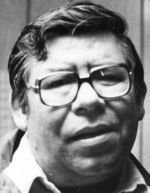American Indian Movement and Dick Wilson
 |
| AIM's Symbol |
In 1968, the American Indian Movement (AIM) was created in Minneapolis. This group of young Indians had become expertise at using occupation as a protest. [1] In 1974, AIM occupied the headquarters of the Bureau of Indian Affairs and vandalized the building. In 1973, a white man killed an Indian by Custer, South Dakota. This man was charged with manslaughter, not murder, by local officials, causing AIM to react with anger. At the courthouse, 200 AIM members forced their way in and were attacked by law enforcement. The AIM members retaliated by lighting the courthouse in flames and destroying the town surrounding. [2]
 |
| Dick Wilson |
Meanwhile, 50 miles from Custer, the Oglala Lakota (more often known as the Sioux) living on Pine Ridge Reservation were having their own difficulties. Elected chairman, Dick Wilson, had taken the job of traditional chiefs and used his power to disadvantage many of the Oglala Lakota living on the reservation. Wilson favored those who were "mixed race, assimilated Indians, like himself" over the full-blooded Sioux who still spoke their language and followed the customs of the traditional chiefs of the past. [3] Because of Wilson's favoring toward the non-traditional Oglalas, food, protection, and funds were distributed unequally throughout the reservation. Wilson and his people, referred to as GOONS (Guardians of our Oglala Nation), were challenged for corruption within the tribal government by the traditional Sioux and responded with violence. When charges were pressed, Wilson threw them out of court, making it impossible for the people to gain fairness and equality. [4] Because of Wilson's powerful threats and actions, many policemen were afraid to arrest any one of Wilson's "Goons," regardless of the fact that they constantly broke the law. In addition to this, many of the men in the police force were non-traditional Oglalas, meaning that Wilson favored and helped them. In an effort to keep that favor and support, these men did not arrest any Goons. In an interview for PBS's documentary We Shall Remain: Wounded Knee, Marvin Stoldt, a BIA police officer and non-traditional Oglala, said, "He helped me a number of times, so I felt that I owed him a loyalty and so I didn't support everything he did but [regardless] of what he did, I still felt that loyalty." [5]
Finally, the traditional Sioux having enough of being treated so poorly, started a civil rights commission and began gathering evidence of the corruption within the tribal government. In February 1973, impeachment hearings were held by the tribal council, but failed due to Wilson's threats to witnesses and council members. Many tribal members felt no hope. One traditional Oglala woman said, "Well I believe that the time has come that we have to commit violence in order to be heard. I don't wanna see anybody killed or anything, but the time is gonna come one of these [times when] violence might have to be in order to wake the people up." [6] It was with this attitude, that the Sioux living in Pine Ridge approached the AIM for help.
[1] Faragher et al., Out of Many: A History of the American People, vol. 2 (New Jersey: Prentice Hall, 2012), 78.
[2] Columbia University, Press. 2011. "American Indian Movement." Columbia Electronic Encyclopedia, 6Th Edition 1. History Reference Center, EBSCOhost (accessed March 4, 2012).
[3] John Kusiak, We Shall Remain: Wounded Knee, DVD, Stanley Nelson (2009: PBS), web.
[4] “Siege
at Wounded Knee 1973.” Redhawk’s Lodge, 2002.
siouxme.com/lodge/aim_73.html
[5] John Kusiak
[6] John Kusiak


No comments:
Post a Comment